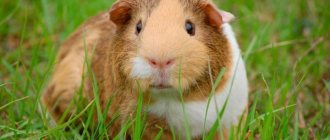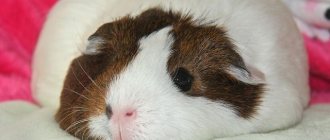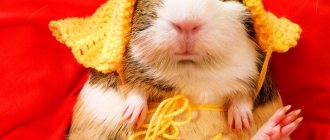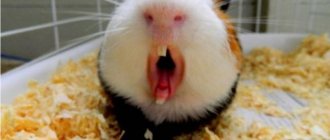Guinea pigs or cavias are funny and cute animals, and watching their behavior is a pleasure. By the habits and behavior of the animal, you can understand its mood, well-being, and find out whether it is hungry. If a breeder has several guinea pigs, he will quickly see differences in the characters of the animals: one pig may be calmer, another - active, the third - shy. The animals have become so popular that even some dream books give meanings of what cavy dreams mean. Thus, a dream about a guinea pig promises joy, while a black cavy promises trouble.
If you dreamed of an animal happy with life, you need to wait for news, and buying a pig in a dream means meeting an old friend.
First: catch me if you can
Don’t take it to heart when you approach a guinea pig with the intention of picking it up, and it just blows away from you with all its agility! This is completely normal, you still have to gain your pet's trust. In the wild, our funny piglets are a tasty prey for many predators, so if you can run fast, then you are safe. Pigs simply cannot curb their instincts when someone invades their space. Finally, remember your own reaction to unexpected sharp and loud sounds. You'll probably jump when a car creeps up behind you and honks its horn? Then don't be offended by your pig!
Guinea pig behavior
Cavias differ from other rodents in that they produce a wide variety of sounds:
- Squeak,
- squeal,
- Mumbling
- cooing,
- Grunt,
- Purr,
- Grunt,
- Clicking,
- Tweet.
Each situation has its own sound. If a guinea pig is hungry, it begins to squeak loudly and annoyingly. In case of fear, the animal emits a quiet and plaintive whistle. A satisfied animal grumbles barely audibly, and when communicating with another guinea pig it makes a funny grunt. An animal can grunt while going about its business: eating, cleaning its fur, digging in the hay. Kavyas click their teeth only when establishing a hierarchy and protecting their borders.
Like all other animals, guinea pigs have different moods. A good mood can be recognized by the activity of the cavy, and if the animal sits motionless, this indicates that the pig is in a bad mood. Usually, the mood of kavias changes before bedtime - sleepy animals become more irritable and dissatisfied. This is due to the fact that in nature they are exposed to great danger during sleep. This is why the pig sleeps for 10-15 minutes several times a day. Some cavy sleep with their eyes open. An interesting feature is that the guinea pig sits while sleeping, and does not lie down, like most animals. Animals lie down while resting or because they feel unwell.
Seventh: get up
Guinea pigs have tiny, barely visible hind legs, which make it difficult to lean on them even to better see the world around them. And yet, guinea pigs sometimes delight us with an amazing pose when they stand up on their hind legs! This is the so-called “curious” pose, which allows you to quickly examine something new, emitting an unfamiliar smell, while the animal sniffs funnyly. A guinea pig can also beg you for a treat in this position, and you will never be able to refuse!
Guinea pig behavior in a pack
The individual habits of guinea pigs are best demonstrated in a pack. It is quite difficult to notice the individual characteristics of an animal living alone. But in the circle of relatives, each kaviya shows its true character and habits. You can often observe that one of the pigs suddenly begins to run around the cage, kicking its paws and shaking its head. The Americans came up with a name for this behavior - popping, by analogy with corn kernels bouncing during roasting. The animal's funny and strange behavior means that it is content and happy, and only appears when two or more animals are kept together. Living in a group, some guinea pigs begin to mark their territory, leaving strong-smelling marks. Most often, these marks are intended for individuals of the opposite sex and indicate readiness for mating and dominance.
When keeping a group of pigs, you can notice a pronounced hierarchy.
Some pigs occupy a dominant position and often start fights if someone tries to overthrow them from their position. Usually the dominant individual is more active, rests in the house or even on its roof, if it can climb, and is the first to choose tidbits. However, this does not mean that all other animals are infringed on their rights. Usually a family or group of pigs is a fairly friendly and cheerful community.
Eighth: let's lick
Guinea pigs are big fans of licking themselves, tidying up their rich fur. Trying to reach “hard-to-reach” areas of the body, guinea pigs also stand up on their hind legs. It is impossible to look at this with indifference. Guinea pigs are very clean, so they do not need regular bathing procedures. Help your pet by checking for ticks and fleas. Despite the Russian name “guinea pigs,” pigs do not really like water. Sometimes guinea pigs may lick each other or even lick you. This can be regarded in two ways: both as a manifestation of love, and as a possible love for the smell of your skin. At least that's what scientists think.
Personality of guinea pigs
Cavias are social and friendly animals by nature. They are not characterized by aggression and many bad habits inherent in rodents. They do not tolerate loneliness well, they need daily communication with their owner and the opportunity to run around the apartment. Many novice breeders buy one animal and notice after a while that the animal’s behavior changes. If the owner does not have enough time for the animal, the pig begins to get bored - it becomes more lethargic, loses appetite, the animal may experience itching and hair loss due to stress. To avoid this, the animal needs to buy a pair. The second pig does not have to be of a different gender. Two females get along well with each other, but whether it is possible to keep two males depends on the breed. If a guinea pig lives alone and there are other pets in the house, then it can easily make friends with them. Rabbits, hamsters, dogs and cats, and even birds become good friends for pigs.
Sometimes breeders wonder whether Kavia can live in the same cage with rabbits or hamsters. The answer is no.
The main danger for cavy is the large difference in diet and possible infections.
Very often you can observe that a guinea pig licks the owner's hands. Sometimes this is caused by the smell of something tasty on your hands, and in most cases it is gratitude for attention and good treatment. This is how the animal expresses its affection and tenderness.
Guinea pigs have a calm and good-natured character - this is what makes them such popular pets for children.
They are sensitive to affection, quickly get used to their owner, respond to their name and even understand simple commands. The more communication, the better. To establish contact and have a good relationship, you need to know how to pet a guinea pig correctly:
- Stroking starts from the head,
- Stroke the animal only according to its fur growth,
- Scratch behind the ears, under the chin or sides, along the back,
- Some animals love tummy rubs.
However, in some cases, a good-natured animal can show sudden aggression and bite. Most often this happens when the owner tears the animal away from food or water, and also wakes the animal from sleep. An animal that has just arrived in a new home can also bite. For a pig, moving is a lot of stress and it needs time to get used to the new owner, smells, sounds and other animals. You should not immediately embrace the cavy in a warm hug - a frightened animal may bite painfully.
What does a pet need to live at home?
Safe keeping of a pig without comfortable conditions for it is almost impossible to imagine. That is why special attention should be paid not only to the temperature and humidity of the air, but also to the cage, as well as the corresponding accessories. This will ensure longevity for the pet and also protect it from all sorts of diseases characteristic of animals in captivity.
Cell selection
A guinea pig is an active and inquisitive animal, so there should be plenty of space for it in the cage. The minimum dimensions of the cage base correspond to 0.7–0.8 m² (30×25 cm, etc.). The height of the house is also considered important so that the animal does not feel cramped; there should be a distance of at least 35 cm from the floor to the lid.
Important! If possible, the cage should be replaced with an artificial pen (in one of the corners of the room); a compressed space inherently does not contribute to the necessary comfort.
In addition, a good cage meets the following requirements:
- has a solid solid bottom;
- made of durable but breathable material (mesh cages are considered the best option);
- consists of one general level; multi-level structures can lead to falls and injuries to the pet;
- created only from safe materials and coatings.
Accessories
The main accessory of the cage is the so-called sleeping place. It is a small covered structure with a 5x5 cm hole. Here the animal must build itself a hole in which it will hide for sleep and from danger. To do this, they use both special purchased houses and improvised materials, while the cheapest is considered to be an ordinary card box.
Pay attention to the information on how to raise guinea pigs at home.
In addition to the house, each owner must install a drinking bowl and feeder made of food-grade plastic or metal in the cage. The drinking bowl can be open or closed, while from a hygienic point of view, closed models with a push valve are considered the best option. The feeder must be open; it is often a small saucer, about 5 cm in diameter. There are also special models of hanging feeders that are mounted on the walls of the cage.
What can you feed
The basis of a rodent's diet is dry grass; there should always be a lot of it, since the rodent constantly chews. Alfalfa is considered the best option for young animals (up to 6 months). In addition to it, adults can also be given dry bluegrass or timothy grass. In addition to hay, no more than 20% of the daily diet (about one cup) should be fresh carrots, corn, celery, cucumbers, broccoli, tomatoes, and green peas. You can also feed your rodent fresh apples and strawberries, as well as bluegrass or timothy greens.
Important! It is completely forbidden to give guinea pigs arugula, cauliflower, iceberg lettuce, radishes and potatoes. They can cause indigestion and related disorders.
In addition, you can give your pig nuts in small quantities. They will saturate her body with the necessary amount of fats and vitamins important for an active lifestyle. The best option is considered to be walnuts and hazelnuts, but you should definitely avoid almonds, they contain all kinds of toxins that can poison a rodent.
Owner reviews
Naturally, elite guinea pigs are not available to the average buyer. In any case, if you plan to breed them, purebred specimens should be selected.
Interesting to know! Experimental research on rabbit breeding in our country has not yet reached such a high level as abroad. And yet, true connoisseurs of these animals try to buy individuals with an attractive and exotic appearance.
It should also be remembered that long-haired and short-haired breeds cannot be crossed, as the result will be offspring that are of poor quality crossbreeds, and no one will allow them to put on a show. Moreover, crossing different breeds is also unacceptable. and because it prevents the improvement of the racial data of both species.
Guinea pigs have earned the right to be considered one of the most wanted pets. Ease of care and maintenance is acceptable for everyone, even novice owners. This is an affectionate and sociable animal, great for families with children.
Interesting facts about the rodent:
- Guinea pigs were domesticated in the 5th millennium BC. e. Andean tribes of South America (today Colombia, Ecuador, Peru and Bolivia) in order to eat rodent meat. During archaeological excavations in Peru and Ecuador, statues of guinea pigs were found dating back to 500 BC. e. before 500 AD e. They were worshiped by the Mochica people. Nowadays, in South America, guinea pigs continue to be eaten (in Peru, up to 65 million animals are used for this purpose per year). Guinea pig meat is similar in taste and nutritional value to rabbit and chicken meat, and is considered dietary.
- Selection work to develop guinea pig breeds lasted from 1200 to 1532. And during the period of the Great Geographical Discoveries, traders from Spain, Holland and England brought pigs to Europe, where they gained popularity as pets at royal courts (for example, Queen Elizabeth I of England).
- The scientific name of the species "Cavia porcellus" is Latin for "little pig". Breeders often use the more formal name cavy or cavey. The comparison of these animals with pigs is not entirely clear. Possible causes include the characteristic sounds guinea pigs make, the proportions of their head to body size, their thick necks, and lack of a waist. In addition, guinea pigs constantly eat and live in small pens that were used to breed pigs on ships, which makes them generally similar to ordinary pigs.
- Guinea pigs are capable of making a variety of sounds, each of which has its own designation. So, during pregnancy, females, and sometimes males too, make chirping sounds that are vaguely similar to birdsong. Guinea pigs “chirp” for 2 to 15 minutes, usually at dusk or at night. When courting females, males make rumbling sounds, a kind of “mating song.” Similar sounds are also characteristic of dominant pigs, which live together with a group of relatives, and with their help show which of them is in charge.
- Penicillin is a deadly poison for guinea pigs.
Communication with other animals
Not only guinea pigs, but also other pets can live in the house. They can get used to dogs and are not afraid if they behave peacefully. But you shouldn’t leave them together unattended, in case the dog’s hunting instincts awaken.
The cat usually starts hunting the guinea pig, so there is no talk of friendship. Very often she can disturb the animal by jumping onto the cage and trying to reach it with her paw.
It is also undesirable to place guinea pigs and other rodents together; they do not like such proximity. It is acceptable to keep animals with rabbits, but only if the males do not bother them with attempts to mate.











